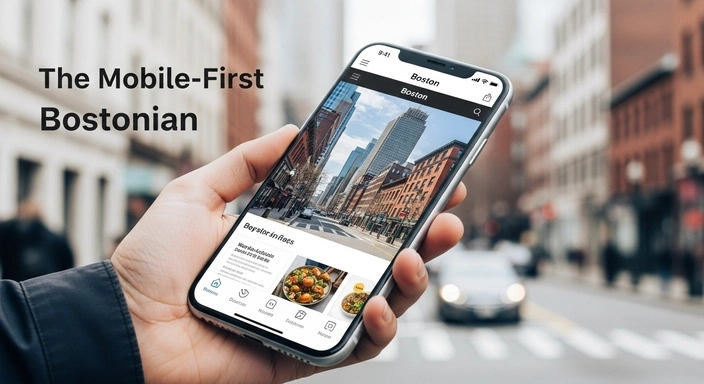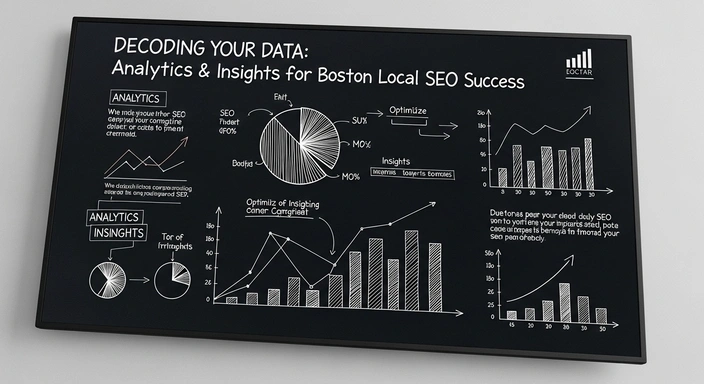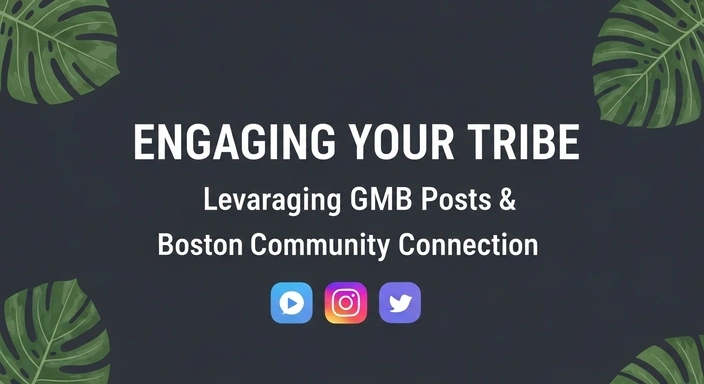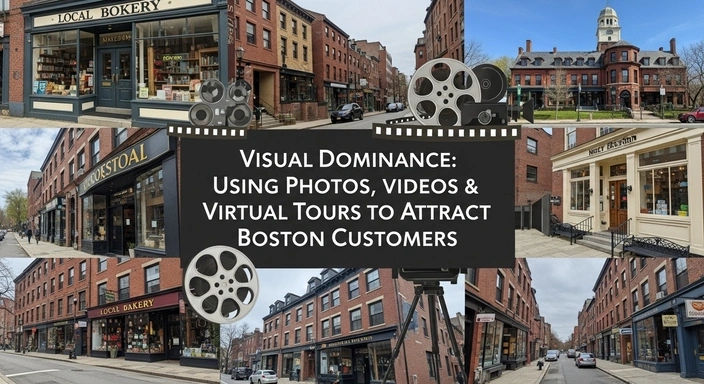This article is the eleventh in our 12-part series: Beyond the Boom: How Boston Businesses Can Dominate Local Search & Drive Foot Traffic in a Shifting Economy. If you missed the previous essential guides, catch up on Visual Dominance: Using Photos, Videos & Virtual Tours to Attract Boston Customers. Discover the full series here.
In our extensive journey to empower Boston businesses for digital dominance in 2025, we’ve systematically constructed a robust framework: analyzing economic shifts, perfecting Google Business Profile (GBP) optimization, dissecting hyper-local search intent, mastering geo-targeting, cultivating five-star reputations, earning authoritative local links, crafting hyper-local content that converts, achieving visual dominance, and engaging deeply with your local tribe. We’ve even learned to decode the data that reveals what’s working and what’s not. Now, as we approach the culmination of our strategic insights, we turn our attention to the pervasive and undeniably critical reality of modern local search: **The Mobile-First Bostonian.**
Consider the quintessential Boston experience: navigating the labyrinthine streets of the North End, bustling through Downtown Crossing, commuting on the MBTA, or strolling through the Boston Common. In virtually every scenario, a smartphone is within arm’s reach, constantly consulted for directions, restaurant reviews, nearby services, or quick comparisons. This isn’t just a trend; it’s the dominant mode of interaction with the digital world, especially for local queries. For Boston businesses, your website’s performance and user experience on mobile devices are no longer optional “nice-to-haves”; they are fundamental gatekeepers to local visibility, engagement, and conversion. If your mobile site falters, your entire local SEO strategy risks crumbling.
The numbers unequivocally reinforce this reality: mobile devices now account for over 60% of all website visits globally, and for local searches, that figure surges to over 80%. Google solidified this mobile dominance with its “mobile-first indexing,” meaning it primarily uses the *mobile version* of your website for crawling, indexing, and ranking. Furthermore, Google’s Core Web Vitals (CWV)—metrics like Interaction to Next Paint (INP), Largest Contentful Paint (LCP), and Cumulative Layout Shift (CLS)—directly measure the mobile user experience and significantly impact search rankings. A slow, unresponsive, or visually unstable mobile site will not only frustrate potential Boston customers but will also be actively penalized by Google, pushing your business further down the local search results.
This comprehensive guide will deep dive into the absolute necessity of optimizing your website for the mobile-first Bostonian. We’ll explore the critical role of mobile-first indexing and Core Web Vitals, unveil meticulous strategies for enhancing site speed and responsiveness, dissect the nuances of mobile UI/UX design that convert on the go, and delve into the technical SEO specifics that ensure your mobile site is flawlessly discoverable. Mastering mobile optimization isn’t just about adapting; it’s about proactively designing your digital presence to meet Bostonians precisely where they are searching: on their phones, in the moment, ready to act. It’s the ultimate competitive edge for driving calls, foot traffic, and online conversions in our dynamic city.
—
The Mobile Imperative: Why Your Website’s Mobile Performance is Non-Negotiable in 2025
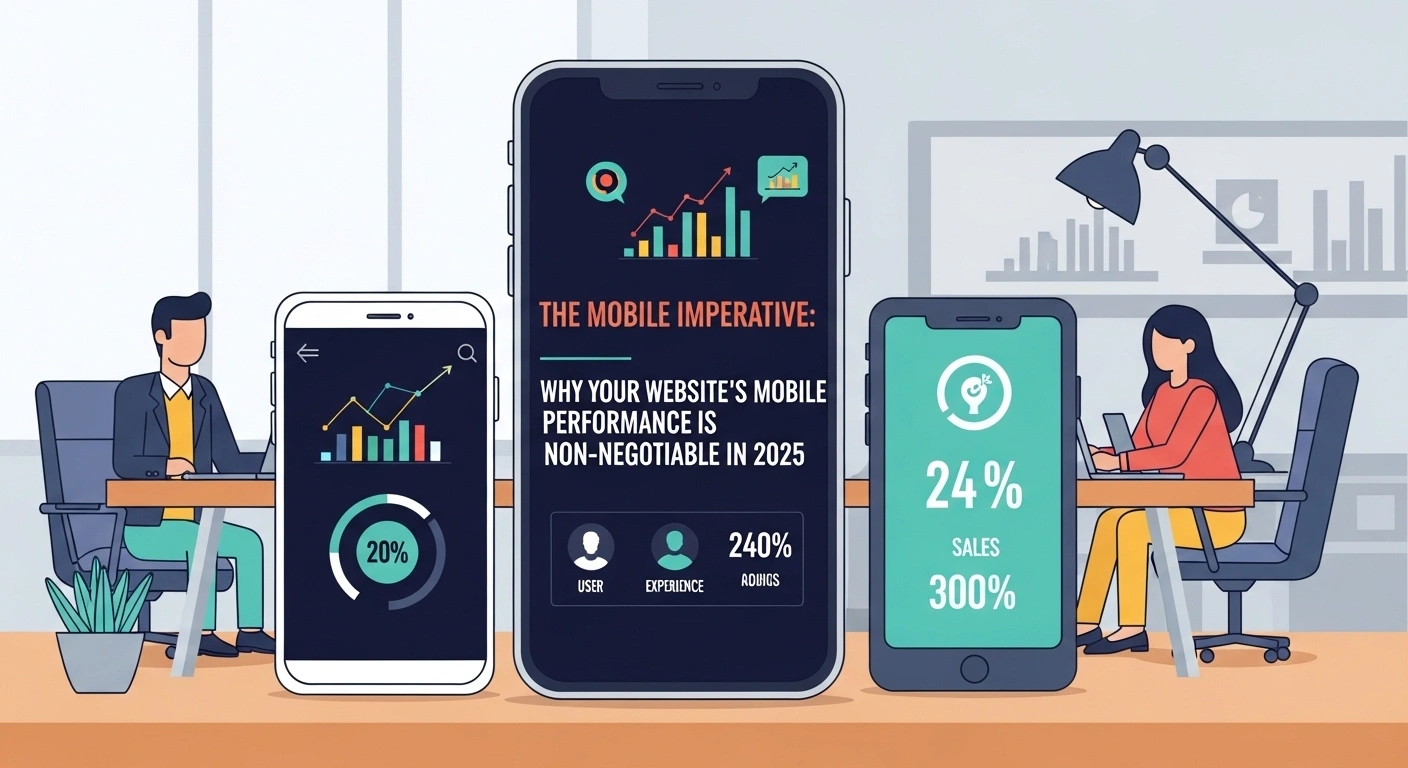
In the digital age, the smartphone has become an extension of the individual, serving as their primary portal to information, connection, and local discovery. For businesses in a bustling, high-density city like Boston, recognizing and prioritizing this mobile-first reality is no longer a strategic choice; it is a fundamental requirement for online visibility and sustained growth. Your website’s mobile performance dictates whether potential customers even find you, let alone engage with your brand.
1. Mobile Dominance in Local Search: Bostonians On-the-Go
The statistics are unequivocal: mobile devices dominate local search. Over 80% of all local searches now originate from mobile devices. This isn’t a passive activity; it’s driven by immediate intent and context:
- “Near Me” Searches: These mobile-centric queries (e.g., “bakery near me North End,” “tire repair near me Allston”) often have an urgent, transactional nature. They are performed by users who are physically close to a location and ready to visit or make a purchase. Mobile optimization ensures your business appears prominently for these high-value searches.
- Micro-Moments: Mobile devices facilitate “micro-moments”—those instant, intent-rich moments when people turn to their device for “I-want-to-know,” “I-want-to-go,” “I-want-to-buy,” or “I-want-to-do” queries. For a Bostonian, this could be checking reviews for a restaurant while walking down Hanover Street, finding directions to a boutique on Newbury Street from the MBTA, or booking a last-minute appointment for a service near their office in the Financial District. Your mobile site must deliver immediate, frictionless value in these moments.
- High Conversion Rates: The intent behind mobile local searches is incredibly high. 76% of smartphone users who conduct a local search visit a business within 24 hours, and 28% of those searches result in a purchase. If your mobile site hinders this journey, you’re losing direct revenue.
2. Google’s Mobile-First Indexing: The Algorithmic Imperative
Since 2018, Google has been steadily rolling out “mobile-first indexing,” which is now the default for virtually all websites. This means Google primarily uses the *mobile version* of your website for crawling, indexing, and ranking. If your mobile site lacks content, functionality, or performs poorly, Google’s understanding of your entire website (both mobile and desktop) will be negatively impacted, leading to lower rankings across the board.
- Content Parity: Ensure all the valuable content and features available on your desktop site are also present and easily accessible on your mobile site. Hidden mobile content might not be indexed.
- Technical Parity: Check that your mobile site has the same structured data (Schema markup), internal links, and meta tags as your desktop version.
- Robots.txt & Meta Directives: Ensure your mobile site isn’t inadvertently blocking Googlebot from crawling important resources.
Ignoring mobile-first indexing is akin to providing Google with a truncated, less valuable version of your website, directly undermining all your other SEO efforts.
3. Core Web Vitals (CWV) & Page Experience: The User’s Judgment, Google’s Metric
Core Web Vitals are a set of specific, measurable metrics that Google uses to quantify a website’s overall page experience, particularly on mobile. They are explicit ranking factors, especially for top search results. Failing to meet CWV thresholds directly impacts your visibility, even if your content is excellent.
- Interaction to Next Paint (INP): The New Responsiveness Standard. As of March 2024, INP officially replaced First Input Delay (FID) as a Core Web Vital. INP measures the overall responsiveness of a page by observing the latency of all interactions a user makes with the page during its entire lifespan. A low INP score (below 200 milliseconds) indicates that your page quickly responds to user input (taps, clicks, keypresses), which is crucial for interactive elements like menus, forms, and filters on mobile. High INP signals a frustrating, laggy experience.
- Largest Contentful Paint (LCP): The Visual Loading Benchmark. LCP measures the loading performance of a page by tracking the render time of the largest image or text block visible within the viewport. For optimal mobile experience, LCP should occur within 2.5 seconds of the page loading. A slow LCP means users are waiting too long to see meaningful content.
- Cumulative Layout Shift (CLS): The Visual Stability Metric. CLS measures visual stability by quantifying unexpected layout shifts of content on the page during loading. A low CLS score (below 0.1) means content doesn’t unexpectedly jump around as it loads. This prevents frustrating mis-clicks (e.g., trying to tap a button that suddenly moves when an image loads above it), particularly irritating on a small mobile screen.
Meeting CWV thresholds is non-negotiable for competitive local SEO in 2025. It directly influences rankings, boosts user engagement (lower bounce rates, longer dwell times), and improves conversion rates.
—
Key Mobile Optimization Strategies: Building a Seamless Experience for Bostonians

Achieving mobile dominance requires a multi-faceted approach, encompassing technical optimization, content presentation, and user interface design. Every element must be meticulously crafted to cater to the mobile-first Bostonian.
1. Responsive Design: The Cornerstone of Mobile Optimization
Responsive web design is the industry standard for creating mobile-friendly websites. It ensures your website fluidly adapts its layout, content, and imagery to fit any screen size, from a large desktop monitor to a small smartphone.
- Fluid Grids: Use relative units (percentages, ems, rems) instead of fixed pixels for layout, allowing elements to scale proportionally.
- Flexible Images: Images should also scale, preventing horizontal scrolling and maintaining visual integrity.
- Media Queries: Use CSS media queries to apply different styles (e.g., hiding certain elements, changing font sizes, reorganizing columns) based on screen size or device characteristics.
- Common Pitfalls to Avoid:
- Text Overflows: Text running off the screen.
- Tiny Text/Buttons: Content too small to read or buttons too small to tap accurately.
- Horizontal Scrolling: The site is not contained within the viewport.
- Desktop-Only Features: Functionality (e.g., complex hover menus, Flash content) that doesn’t work on mobile.
- Slow Loading on Mobile: Responsive design still needs speed optimization.
- Adaptive Design (Alternative): While responsive is generally preferred, adaptive design (serving different, pre-defined layouts for specific screen sizes) can be an alternative for very complex sites, but it’s more resource-intensive to manage.
2. Site Speed Optimization for Mobile: Every Millisecond Counts (Especially for CWV)
Mobile users are notoriously impatient. A slow-loading site frustrates them, leading to high bounce rates and abandonment. Site speed is a direct CWV factor (LCP, INP). Google explicitly states that page speed is a ranking factor.
- Image Optimization: The Biggest Culprit.
- Compression: Compress all images for the web. Use tools like TinyPNG, ImageOptim, or WordPress plugins (Smush, Optimole).
- Modern Formats: Convert images to **WebP** format. It offers superior compression compared to JPEG/PNG. JPEG XL is an emerging format with potential.
- Lazy Loading: Implement lazy loading for all images and videos. Content below the fold only loads when the user scrolls to it, significantly improving initial page load time and INP.
- Correct Sizing: Serve images at the exact dimensions they are displayed. Don’t load a 2000px wide image if it’s only displayed at 400px.
- CDNs (Content Delivery Networks): For Boston businesses serving a broader regional or national audience, a CDN speeds up delivery of static assets (images, CSS, JS) by serving them from servers geographically closer to the user. This is less critical for hyper-local Boston-only services but still beneficial.
- Code Optimization (HTML, CSS, JavaScript):
- Minification: Remove unnecessary characters (whitespace, comments) from HTML, CSS, and JavaScript files to reduce their size.
- Defer & Async JavaScript: Defer (load after HTML parsing) or asynchronously load (load in parallel) JavaScript files that aren’t critical for the initial render. This prevents JS from blocking content display and improves INP.
- Eliminate Render-Blocking Resources: Prioritize critical CSS for above-the-fold content and defer the rest.
- Server Response Time: Your Hosting Foundation.
- Choose a high-performance hosting provider. A slow server response time (Time to First Byte – TTFB) impacts all other speed optimizations.
- Utilize server-side caching to serve pre-generated pages faster.
- Browser Caching: Configure browser caching to store static resources (images, CSS, JS) locally on the user’s device for faster repeat visits.
- Prioritize Above-the-Fold Content (Critical Rendering Path): Ensure the content visible immediately when a page loads is fully optimized to render quickly. This impacts LCP.
3. Mobile User Interface (UI) / User Experience (UX) for Local Conversion
Beyond speed, the usability of your mobile site is paramount for driving local conversions. A frustrating mobile experience will send Bostonians to your competitors, even if your site is fast.
- Intuitive Navigation for Touchscreens:
- Hamburger Menus: Use the ubiquitous hamburger icon for your main navigation, collapsing extensive menus into a clean, mobile-friendly format.
- Clear Labeling: Ensure menu items are clearly labeled and concise.
- Sticky Navigation: Consider a sticky header or footer navigation for easy access to key CTAs (e.g., “Call Now,” “Directions”) as the user scrolls.
- Finger-Friendly Tappable Elements:
- Large Buttons: Buttons and clickable elements (links, icons) should be large enough (at least 48×48 CSS pixels) and have sufficient spacing to prevent mis-taps. Google’s Mobile-Friendly Test will flag small tappable elements.
- Clear CTAs: Make your Calls to Action prominent, clear, and easy to tap. (e.g., a large “Click to Call Our Boston Office” button).
- Readability: Essential for On-the-Go Scanning.
- Font Size: Use legible font sizes (at least 16px for body text) with good line height and letter spacing.
- Contrast: Ensure sufficient contrast between text color and background color for easy reading in various lighting conditions (e.g., bright sunlight on the Esplanade).
- Short Paragraphs & Bullet Points: Break up dense text into short, scannable paragraphs and use bullet points liberally. This improves readability for users consuming content quickly.
- Form Optimization for Mobile: Minimize Friction.
- Concise Forms: Keep forms as short as possible. Only ask for essential information.
- Large Input Fields: Make text input fields large and easy to tap.
- Auto-Fill: Enable auto-fill for common fields (name, email, phone).
- Appropriate Keyboards: Use `type=”tel”` for phone numbers and `type=”email”` for emails to bring up the correct keyboard.
- Clear Error Messages: Provide immediate and helpful error messages if a field is entered incorrectly.
- Easy Access to NAP & Key Contact Information:
- Click-to-Call: Implement `tel:` links so users can tap to call your Boston business directly.
- Click-for-Directions: Integrate direct links to Google Maps for directions to your Boston location.
- Click-to-Message: If you use GBP messaging or WhatsApp, ensure direct links are easily accessible.
- Sticky Footer/Header: Often used to keep NAP or primary CTAs visible as the user scrolls.
—
Technical Mobile SEO Specifics: Under the Hood Optimization
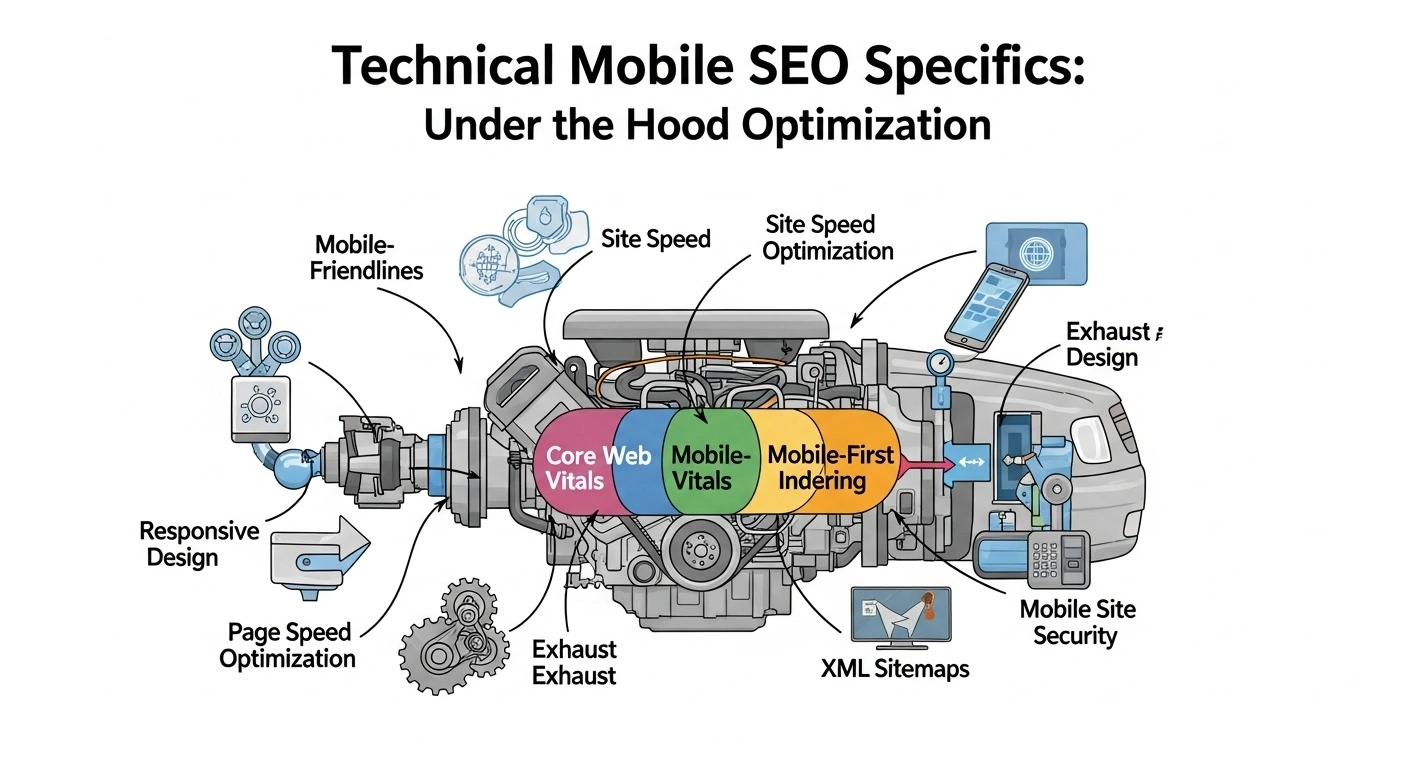
Beyond design and speed, specific technical elements are crucial for ensuring Google properly crawls, indexes, and ranks your mobile content, particularly in the complex local search environment.
1. Viewport Meta Tag: Essential for Responsiveness
The `viewport` meta tag is a fundamental HTML element that tells browsers how to control the page’s dimensions and scaling on different devices. Without it, mobile browsers might render your page at desktop width, requiring users to pinch-to-zoom.
- Implementation: It should be placed in the “ section of your HTML:
<meta name="viewport" content="width=device-width, initial-scale=1.0"> - Why it matters: This simple tag is crucial for enabling responsive design, ensuring your content scales correctly and preventing Google’s “Content wider than screen” or “Text too small to read” mobile usability errors.
2. Mobile XML Sitemaps: Guiding Googlebot for Mobile-First Indexing
While a single XML sitemap can work for responsive sites, ensuring your sitemap correctly reflects your mobile-optimized content is vital for mobile-first indexing. For large or complex sites, or those with separate mobile URLs, a dedicated mobile sitemap can be beneficial.
- Include All Mobile Pages: Ensure your sitemap lists all your mobile-optimized pages, especially your local landing pages and hyper-local blog posts.
- XML Sitemaps for Images & Videos: As discussed in Post 8, separate sitemaps for visual assets are crucial for their mobile discoverability.
- Submit to GSC: Always submit your sitemaps to Google Search Console to help Google discover and crawl your mobile-optimized content efficiently.
3. Structured Data (Schema Markup) for Mobile: Enhancing Context for AI
Schema markup (structured data) is even more critical for mobile, as it helps Google understand the context of your content, allowing for rich snippets and direct answers in mobile-optimized search results, especially in AI Overviews (SGE).
- Local Business Schema: Crucial for providing explicit details about your Boston business (NAP, hours, reviews, categories) in a machine-readable format. This enhances your GBP’s mobile display.
- Review Schema: Displays star ratings in mobile search results, providing instant social proof.
- FAQPage Schema: Provides direct answers to user questions, often displayed as expandable accordions in mobile SERPs.
- Service/Product Schema: Clearly outlines your offerings, particularly useful for mobile users scanning for specific items or services.
Ensure your schema markup is correctly implemented and valid using Google’s Schema Markup Validator and GSC’s “Enhancements” reports. This helps your content appear in mobile-friendly rich results, increasing visibility and CTR.
4. Accelerated Mobile Pages (AMP): Speed at Scale (with Caveats)
AMP is an open-source framework designed to create fast-loading mobile pages. While it delivers undeniable speed, its SEO benefits as a direct ranking factor have diminished in recent years, though it remains a performance enhancement.
- Pros: Extremely fast loading, potentially better user experience on slower connections, and eligibility for Google News carousel.
- Cons: Requires separate AMP versions of pages, content can be limited (strips out some JS/CSS), can be difficult to maintain, and Google’s focus has shifted more towards general Core Web Vitals for all pages.
- Relevance in 2025: For most Boston local businesses, optimizing your core responsive website for CWV and overall speed is more impactful and resource-efficient than implementing AMP. It might still be considered for large news publishers or e-commerce sites with vast content libraries.
5. Progressive Web Apps (PWAs): The App-Like Mobile Experience
PWAs are web applications that look and feel like native mobile apps. They offer enhanced performance, offline capabilities, and push notifications, blurring the line between web and app. While not a direct SEO ranking factor, PWAs enhance user engagement and can lead to increased repeat visits and conversions.
- Benefits for Boston Businesses: Improved speed, offline access (useful for MBTA commuters with patchy signal), push notifications for offers/updates (e.g., a flash sale at a Back Bay boutique), and an “add to home screen” option for quick access.
- SEO Relevance: PWAs improve overall user experience, which indirectly boosts SEO through better engagement signals (lower bounce rates, longer session durations). They’re highly discoverable via search engines, unlike native apps.
- Consideration: Building a PWA is a significant development effort, typically considered after core website mobile optimization is perfected.
—
Boston-Specific Mobile Optimization Nuances: Catering to the Local Lifestyle
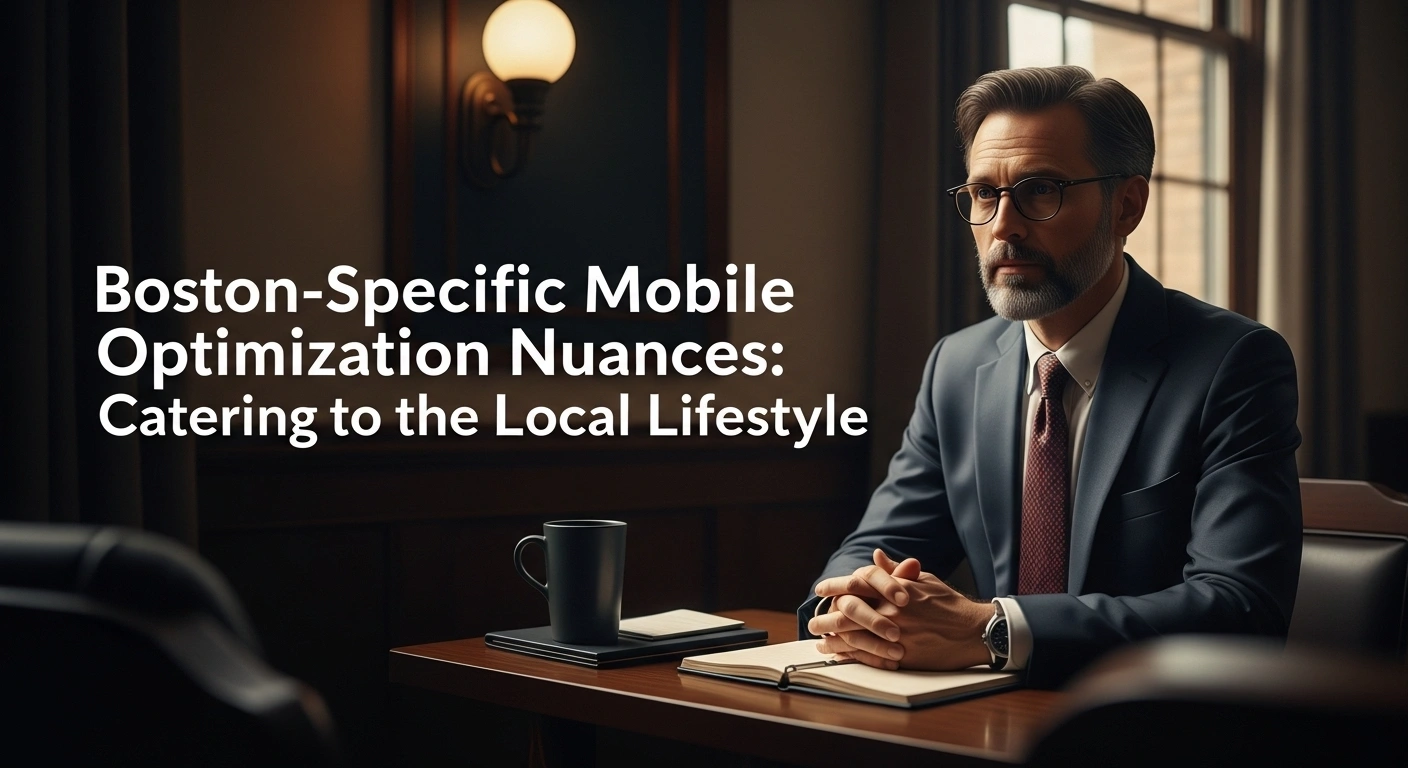
Optimizing for mobile is universally important, but for Boston, certain nuances of local lifestyle, demographics, and infrastructure make it even more critical and inform specific strategic approaches.
1. The MBTA & Commuter Lifestyle: Searches On-the-Go
Boston’s extensive public transit system means a significant portion of its population is frequently moving, often commuting, and relying heavily on their smartphones. This is prime “on-the-go” search territory.
- Optimize for Quick Answers: Users on the T need quick answers. Ensure your GBP is pristine (hours, phone, directions), and your website’s key information is immediately visible on mobile.
- Offline Access (PWAs): For certain services or content, a PWA could be invaluable for MBTA users who might lose signal underground.
- Timely Information: A restaurant near a T station could use GBP Posts to promote “lunch specials for commuters” during peak hours.
2. Dense Urban Environment: Precision Location Needs
Boston’s tightly packed streets, numerous landmarks, and multi-story buildings mean precise location information is crucial. Mobile searchers are often looking for businesses on a specific block or within a very small radius.
- Meticulous Geo-Targeting: Double down on the geo-targeting strategies from Post 4, ensuring your mobile site and GBP are optimized for specific Boston neighborhoods and landmarks.
- Interactive Maps: Ensure embedded Google Maps on your mobile site are highly interactive and allow for immediate direction requests.
- Visual Wayfinding: High-quality exterior photos and virtual tours (as discussed in Post 8) are crucial for helping mobile users identify your business in a dense urban environment.
3. Tourism & Hospitality Focus: The Visitor’s Mobile Guide
As a major tourist destination, many visitors to Boston rely solely on their mobile devices for navigating, finding attractions, dining, and shopping. Businesses in the tourism, hospitality, and retail sectors in areas like Downtown Crossing, Faneuil Hall, or the Waterfront are heavily reliant on mobile visitors.
- Multi-Language Options: If catering to international tourists, ensure your mobile site can easily switch languages.
- Event Integration: Promote local Boston events and attractions on your mobile site, tying them to your services.
- Click-to-Call/Book/Directions: These CTAs are paramount for converting tourist mobile searchers.
4. Weather Impact: Reliable Access in All Conditions
Boston’s sometimes extreme weather (snowstorms, heatwaves) makes reliable mobile access even more important. Users need quick information on closures, modified hours, or emergency services during adverse conditions.
- Robust Mobile Hosting: Ensure your hosting can handle traffic spikes during emergencies.
- Clear Messaging: Use GBP Posts and prominent website banners on mobile to communicate urgent updates.
5. Mobile-Dependent Industries in Boston
Certain industries inherently rely more heavily on mobile optimization in Boston:
- Restaurants & Cafes: Mobile menus, online ordering, reservations, waitlist management.
- Retail: Product Browse, in-store availability, online shopping, loyalty programs.
- Personal Services (Salons, Spas, Fitness): Online booking, class schedules, membership management.
- Home Services (Plumbers, Electricians): Emergency contact, quick quotes, service booking.
- Medical/Urgent Care: Appointment booking, tele-health access, nearest location, wait times.
For these businesses, mobile optimization is directly proportional to market share.
—
AI’s Influence on Mobile SEO in 2025: Intelligent Optimization for On-the-Go

Artificial Intelligence is not only transforming core search algorithms but is also profoundly reshaping mobile SEO. AI’s capabilities allow for a deeper understanding of user context, predictive insights, and optimized content delivery on mobile devices.
1. AI Overviews (SGE) & Mobile-First Design
Google’s Search Generative Experience (SGE) and its AI Overviews are inherently optimized for mobile display, often appearing as concise, scrollable summaries at the top of the mobile SERP. To be featured here, your content must be:
- AI-Readable: Well-structured with clear headings, bullet points, and concise answers that AI can easily synthesize for mobile-friendly summaries.
- Comprehensive & Authoritative: Providing deep, E-E-A-T-backed content that AI can trust to pull information from.
- Fast Loading: A slow page won’t get featured in AI Overviews, regardless of its content quality. Core Web Vitals are a gatekeeper here.
- Visually Optimized: AI Overviews often include relevant images/videos. Ensure your mobile visuals are optimized for AI recognition.
2. Voice Search Prominence on Mobile
Mobile devices are the primary platform for voice search. As discussed in Post 3, optimizing for conversational, long-tail, and question-based queries is crucial for mobile voice searchers (e.g., “Hey Google, find a sushi restaurant open now near Tufts Medical Center”). AI powers the understanding of these complex natural language queries.
3. AI’s Evaluation of Mobile UX Signals
AI algorithms are becoming more sophisticated at interpreting subtle mobile user experience signals. Beyond explicit CWV metrics, AI can infer user frustration (e.g., excessive scrolling, rapid back-button clicks, abandonment of forms) or delight (e.g., extended dwell time, multiple interactions, high conversion rates).
- Predictive Metrics: GA4’s AI-powered predictive metrics (e.g., churn probability, purchase probability) are increasingly influenced by mobile user behavior patterns.
- Personalization: AI can dynamically adjust mobile search results based on a user’s device, location history, and inferred intent, making highly optimized mobile sites more likely to appear.
4. Generative AI for Mobile Content Optimization
Generative AI tools can assist in optimizing content specifically for mobile displays:
- Responsive Content Adaptation: AI can help auto-summarize long text for mobile snippets, suggest optimal image cropping for different screen sizes, or generate mobile-specific CTA variations.
- Dynamic Content Delivery: AI can dynamically serve content elements based on mobile user context (e.g., showing a specific local offer if the user is detected in a particular Boston neighborhood).
- Mobile Form Optimization: AI can suggest streamlined mobile-first form designs and optimal input field types.
—
Measuring Mobile Performance: Analytics for Your On-the-Go Boston Audience

Rigorous measurement of your mobile SEO performance is non-negotiable for proving ROI and ensuring continuous improvement. Leverage Google’s own tools and other platforms to gain actionable insights into your Boston mobile audience.
1. Google Search Console (GSC): Mobile-First Health Check
GSC is your essential diagnostic tool for understanding how Google crawls, indexes, and perceives your mobile website.
- Mobile Usability Report: This is paramount. It highlights specific mobile usability errors (e.g., “Text too small to read,” “Clickable elements too close together,” “Content wider than screen”). Fix these immediately.
- Core Web Vitals Report: Monitor your INP, LCP, and CLS scores for mobile. This report directly shows how your site performs for real users. Drill down into specific URLs to identify performance bottlenecks.
- Performance Report (Device Filter): Filter your performance data by “Device: Mobile” to see impressions, clicks, and average position exclusively for mobile searches. Compare this to desktop performance.
- Index Coverage Report: Ensure all your important local mobile pages are indexed. Look for “mobile-first indexing issues” or “excluded by `noindex` tag” errors.
2. Google Analytics 4 (GA4): Mobile User Behavior & Conversions
GA4 provides granular insights into how mobile users interact with your website and convert into customers.
- Device Category Report (`Reports > Tech > Overview > By Device category`): See the proportion of your traffic from mobile, desktop, and tablet. Track trends over time.
- Engagement by Device: Compare engagement metrics (engaged sessions, average engagement time) across mobile vs. desktop. If mobile engagement is low, it signals UX issues.
- Conversions by Device: Crucially, analyze your conversion rates (calls, forms, purchases) specifically for mobile users. Are mobile users converting at the rate you expect? If not, focus your optimization efforts here.
- Geo-Location Reports (Mobile Segment): Segment your geo reports (city, region, custom Boston neighborhoods) specifically for mobile traffic. Understand where your mobile users are coming from and how their behavior differs.
- User Journey: Analyze user flow through your website, specifically for mobile users. Are they encountering friction points?
3. Google Business Profile (GBP) Insights: Mobile-Driven Actions
Many GBP actions are initiated from mobile devices. Your GBP Insights (as detailed in Post 10) implicitly reflect mobile performance.
- Direction Requests: Almost exclusively mobile-driven. Track these.
- Phone Calls: Often initiated from mobile devices (click-to-call).
- Website Clicks: While not exclusively mobile, a large percentage come from mobile users viewing your GBP.
4. Google PageSpeed Insights: Comprehensive Mobile Speed Audit
Use Google PageSpeed Insights to get detailed performance reports for specific URLs on both mobile and desktop. It provides scores for CWV and specific recommendations for improvement.
- Run Audits Regularly: Test your homepage, key local landing pages, and popular blog posts.
- Prioritize Recommendations: Focus on “Opportunities” and “Diagnostics” that directly impact CWV.
- Track Progress: Monitor scores over time to ensure optimizations are effective.
5. Mobile-Friendly Test: Quick Check for Basic Compliance
Google’s Mobile-Friendly Test tool provides a quick “pass/fail” assessment of a page’s basic mobile usability. While less detailed than PageSpeed Insights, it’s a good initial check for fundamental issues.
—
Conclusion: The Mobile-First Bostonian — Your Path to Unrivaled Local Dominance
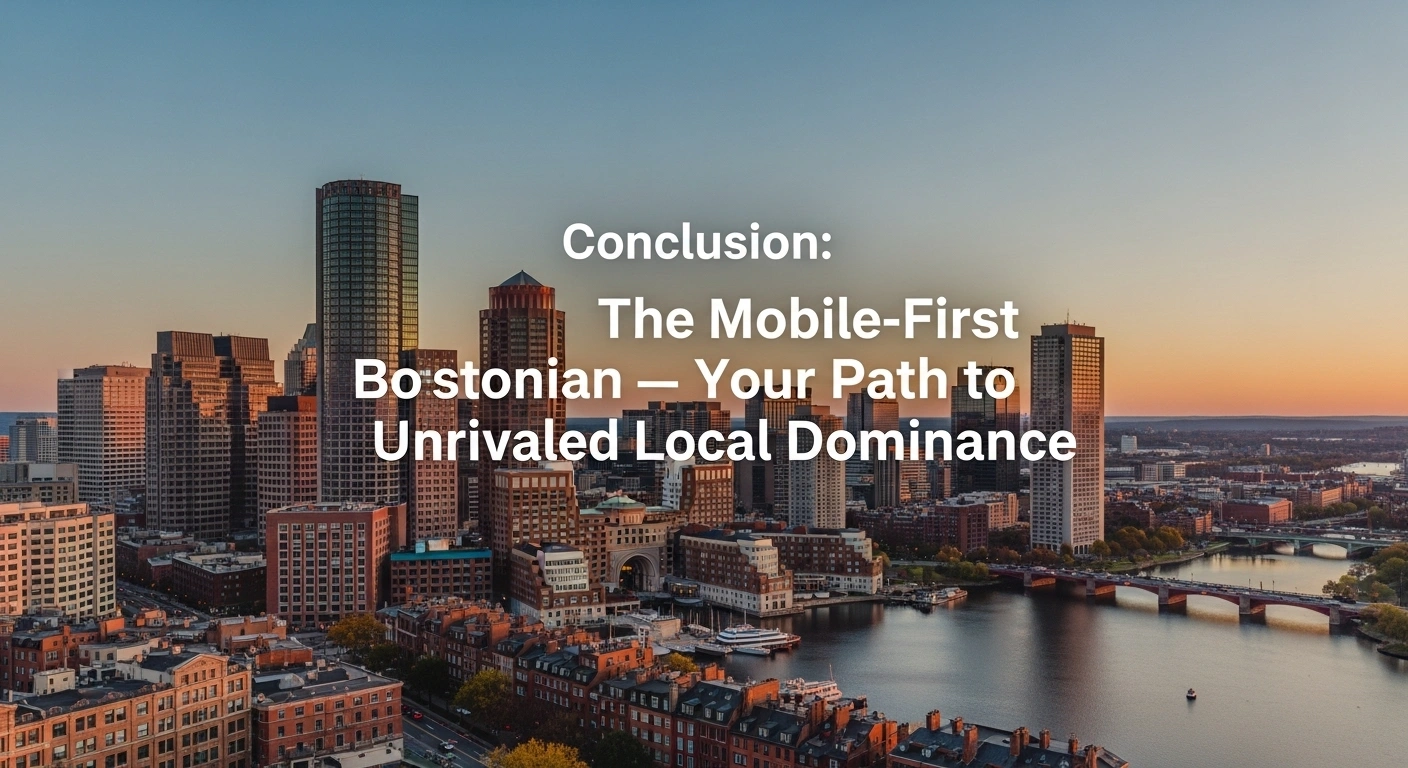
In the dynamic, constantly evolving Boston market of 2025, where the smartphone is the primary interface for local discovery and commerce, **optimizing your website for the mobile-first Bostonian is not merely a strategic advantage; it is the fundamental path to unrivaled local dominance.** Ignoring mobile performance and user experience is tantamount to erecting an invisible barrier between your business and the vast majority of your potential local customers who are searching on the go, often with immediate intent.
By diligently embracing mobile-first indexing, meticulously optimizing for Core Web Vitals (especially INP for responsiveness), relentlessly pursuing site speed enhancements, and crafting an intuitive, frictionless mobile UI/UX, your Boston business ensures that every touchpoint with a mobile user is a positive one. This comprehensive approach not only aligns perfectly with Google’s evolving algorithms and the capabilities of AI-driven search but also builds profound trust and propels conversions, transforming casual mobile searches into loyal customers who walk through your doors or engage with your services.
This comprehensive guide has equipped you with the definitive blueprint for mastering mobile optimization, ensuring your business is perfectly positioned to capture Bostonians whether they are on the MBTA, strolling Newbury Street, or navigating their local neighborhood. You’ve now gained mastery over the fundamental pillars of local SEO. In our final installment, we’ll cast our gaze forward, exploring how to future-proof your Boston business against the rapid technological shifts of AI, voice search, and emerging trends, ensuring your dominance is sustained for the decade to come.
Is your Boston business’s mobile website falling short, losing valuable on-the-go customers to competitors? The experts at **seobostonma.com** specialize in advanced mobile SEO and Core Web Vitals optimization that delivers measurable results for Boston businesses like yours. Schedule a free consultation with our team today and let’s transform your mobile presence into your most powerful local attraction and conversion tool, ensuring your business leads the charge in Boston’s mobile-first market.


